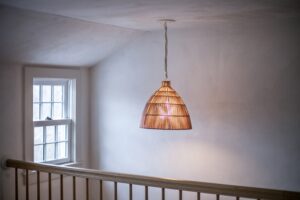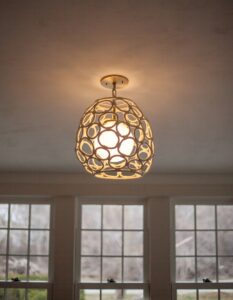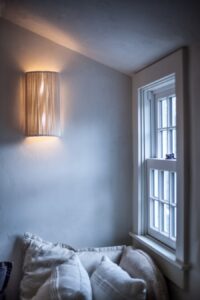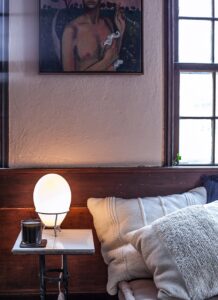Chad Jacobs can’t stand bare lightbulbs. Although they might be trendy in restaurants and coffee shops as a play on an industrial look, he just doesn’t get them.
“You’re constantly squinting,” he says. “In a room, I want to just feel the light but not necessarily look at the light fixtures as a source.”
Jacobs spends a lot of time thinking about how to accomplish that. His lighting designs have always been about light being diffused through some kind of material. He began by working with glass, but since 2015 he has worked primarily with string and rope, creating fixtures that are equally decorative and functional.

Jacobs is a proponent of using multiple light sources, and deployed in his Truro home, which he shares with his husband, Stephen Orr (who has written about gardening in these pages), are a variety of his designs in many shapes and sizes. There are large hanging fixtures, domelike and round; smaller wall sconces threaded with rope; and tabletop lights, including a glowing glass lamp in the shape of an egg.

“People tell me they need a lot of light,” says Jacobs, “and then they only want to use one light source. That’s not going to work no matter what kind of lamp fixture you have.” A lighting designer’s rule of thumb is at least two light sources. “If you have a table lamp, a wall lamp, and a ceiling lamp in a room, usually, you’re set,” he says.
In an alcove off the kitchen — a recent addition to their historic New England house — an orb-like fixture made from white rope hangs from the ceiling encasing a globe pendant. The light source is more obvious here than in most of Jacobs’s fixtures, but the pendant is opaque to obscure the bulb underneath. Here, the rounded form of the light source echoes circular forms stitched together to create the airy and porous armature. Created from strands of rope, each wrapped with a thin twine, this light fixture proved too time-consuming to produce on a large scale.

Jacobs has a few of these experimental one-off or limited-edition pieces in his house in addition to some that are made by his company, where he works with a team of 10 to produce his designs by hand in New York City.
A drum light affixed to the ceiling above the entranceway and an accompanying wall sconce — both neutral in color — are more typical of the products Jacobs produces at scale for domestic settings. Together, the two provide a range of opportunities for full, bright light or something dimmer and more atmospheric. This flexible approach to lighting is achieved not only by using multiple fixtures but also through smart use of dimmer switches.

When designing, Jacobs is always considering the bulb shape and its silhouette. The drum fixture is created from an opaque fabric, fully obscuring the bulb. The light diffused through this material is warm and casts a round glow on the ceiling. Nearby, the wall sconce is more revealing. The strands of rope moving between the armature are loose enough to faintly reveal the shape of chandelier bulbs underneath, which give off a glow that is dispersed gradually on the wall above and below the fixture.
Jacobs came to designing lights by way of architecture, which he studied at the University of Texas, Austin. “My architecture background is always there,” he says. He often begins designing a fixture by establishing a rigid underlying structure that counterbalances the soft nature of the materials surrounding it.

In one large lamp hanging from the ceiling above a stairway, Jacobs references one of architecture’s most famous buildings. Its shape and terra cotta color recall Brunelleschi’s Dome, the 15th-century octagonal dome at the Duomo, which Jacobs saw in Florence. The scale of this fixture, the largest in his house, is well matched by the ceiling height of the stairwell. He’s gone a lot larger on similarly shaped fixtures, some even extending beyond his height. But you won’t see those in his modestly scaled Truro home. “A light fixture should fit the scale of a room,” he says.

If architecture is at one end of his influences, fiber art is at another. Since 1993, when he established his own company, Bone Simple Design, Jacobs has worked with a variety of materials including metal, glass, fabric, and plastics. But in 2015, he saw an exhibition on fiber sculpture at the Des Moines Art Center.
“It blew my mind,” he says. He came back to his studio in Long Island City and went all in with fibers — wrapping, dyeing, and coming up with a collection of shapes that have been a big success for his little company.
Don’t be too sure fiber art has faded since its heyday in the 1970s. For Jacobs, it’s still coming into its own.
